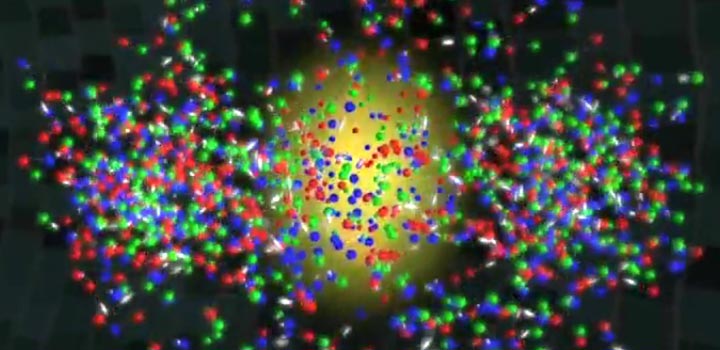YouTube's SciShow Hails Hot Quark-Gluon Plasma as "Superlative Science"
January 18, 2013

Protons, neutrons melt to produce 'quark-gluon plasma' at RHIC
The U.S. Department of Energy's Brookhaven National Laboratory had an exciting year in 2012, making headlines for a variety of accomplishments from setting new performance records in iron-based superconductors to identifying a new mechanism for regulating plant oil production to creating innovative approaches for measuring effects of dark energy in the very early universe. But one breakthrough in particular caught the attention of video blogger Hank Green, who hosts the very popular online program SciShow on YouTube: the fact that scientists at Brookhaven's Relativistic Heavy Ion Collider (RHIC) have collided gold ions together to produce a substance with the highest man-made temperature ever recorded.
SciShow host Hank Green highlights superlative science in 2012, naming Brookhaven's quark-gluon plasma the "hottest" achievement of the year (2:32)
Green, whose program has gotten more than 34 million views in the little over a year he's been on air, wrapped up 2012 with an episode highlighting a year of scientific achievements in a segment titled "10 Science Superlatives of 2012" that aired on December 26. Coming in as the "hottest" achievement of the year is RHIC's creation of quark-gluon plasma, a form of matter reaching a scorching temperature of 4 trillion degrees Celsius—250,000 times hotter than the temperature at the core of the sun. This 'perfect liquid' matter exists at RHIC for less than a billionth of a trillionth of a second, less than the amount of time it takes light to travel across a single proton, but long enough to gain recognition in 2012 with a Guinness World Record. Alas, science marches on, and the Large Hadron Collider at CERN is thought to have since superseded RHIC's record by forming matter at an estimated 5.5 trillion degrees Celsius.
The temperature of the quark-gluon plasma was initially measured by scientists at the PHENIX collaboration at RHIC in 2010, but the Guinness acknowledgement in 2012 put the record-breaking temperature back in headlines. By studying this primordial matter, scientists hope to better understand how quarks and gluons, which floated around space freely immediately after the Big Bang, eventually combined to form protons and neutrons, the building blocks of visible matter. Only after those quarks and gluons combined—a process governed by the strong force—did the constituent parts of individual atoms, stars, planets, and people exist.
The discoveries at RHIC have led to compelling new questions in the field of quantum chromodynamics (QCD), the theory that describes the interactions of quarks and gluons. To probe these and other questions and to provide new insight into nature and its forces, Brookhaven physicists will run RHIC again this year with new studies aimed at understanding proton spin. A longer-term plan seeks to build upon the collider's infrastructure to further explore the fundamental mysteries of matter.
2013-3633 | INT/EXT | Newsroom









